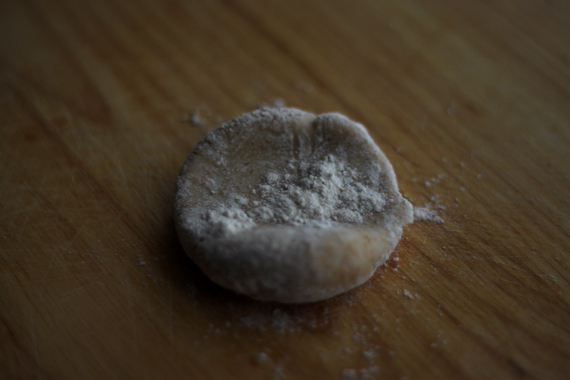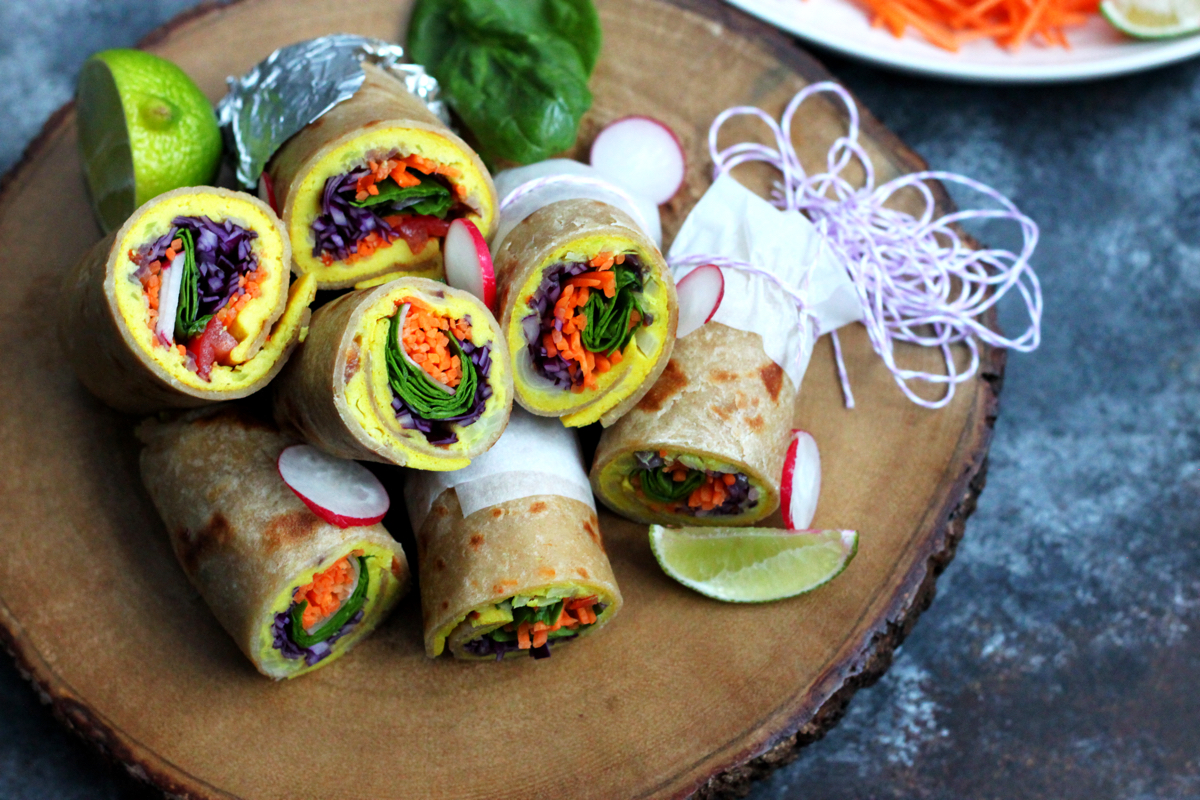
My best Roti Recipe – Softest Ever Chapati (Rotli). The smell that floods a home when the first roti goes on our battered old steel tawa surrounds me with a comfort and joy I cannot even explain.
It’s my most favourite smell in the whole world because it represents my childhood, my family and every moment (both happy and sad) in our home.

Roti Recipe – Softest Ever Chapati (Rotli) – our daily bread
As far as day-to-day cooking goes, chapati (also called roti or rotli) are the glue that sticks everything on the Indian dinner table together. It scoops up curry and daal, pickle and everything in between.

Chapatis are everyday staple and without them, a weeknight meal would be incomplete. I’ve known Gujarati folks who won’t touch their dinner unless there are hot, freshly-made rotli on the table.
What are the different types of Roti?
In Indian cuisine, Chapati come in many different forms. Each region will have a take on it and that take will differ from village to village and home to home. There are no right or wrong answers when it comes to making chapati – it’s all down to personal choice.
Naming also varies depending on local language and dialect. You can find rotis from South Asia to Malaysia and Africa to the Caribbean.
A handful of different names for this unleavened flatbread (from around the world)
- Chapati (or chapatti)
- Roti
- Phulka
- Rotli
- Safati
- Shabaati
- Roshi
… and so many more
Phulka
Typically, Phulka (soft, thin, risen chapati) are most common in Gujarati homes. This is the style I grew up eating. We call them Rotli at home.

Softer and smaller than your average North Indian-style (tandoor cooked) roti (the kind you get in most Anglo-Indian restaurants), these Phulka have oil in the dough and are cooked on a super-hot steel pan (called a tawa or lodhi). So delicious and toasty!
I don’t often cook my rotli over an open flame because they’re so soft, they’d just break. They still puff up like hot air balloons as they cook on the lodhi.
Memories of my mother’s Roti Recipe – Softest Ever Chapati (Rotli)
They are something I was utterly fascinated by as a child. The first thing I ever ‘cooked’ were raggedy, uneven rotlis using my mini rotli-making set my aunty bought me when I was five.
Other recipes you might like:
- Soft Spinach Roti recipe
- Paneer Kulcha recipe
- Buttermilk Naan recipe
- Thepla recipe
- Masala Poori recipe
- Aloo Paratha recipe
From flatbreads to footballs
I’d peer over our cooker wide-eyed at the hot air balloon show my mum told me was happening. The suspense that built up as they rose from flatbreads to footballs was inexplicably exciting for a little girl obsessed with cooking.

I would roll out the same piece of dough over and over again and by the end of it, my poor dad would have to eat the splat-shaped biscuit thing. It would be presented it to him with such pride. Of course, he’d tell me it was delicious that and I was mastering it. I wasn’t.
Thanks Dad.

How I make Roti Recipe – Softest Ever Chapati (Rotli) at home
There’s a certain routine to making rotli you wouldn’t dare mess with. Ask any Indian cook; once their routine is set in its ways, you’d be a fool to question it.
Everything from the patlo (board), to the velan (thin Indian rolling pin) and the tavitho (steel utensil used to flip the rotli), to the number of times the rotli is actually flipped, a cook’s rotli routine is sacred.

Making rotli at someone else’s house is literally the worst. “They never rise, the thickness of the velan is all wrong and the lodhi never gets hot enough”, etc, etc, etc. Of course, when it’s you having to explain your flat-as-a-pancake rotlis, all these excuses are valid.

Can Roti be frozen?
I recommend freezing roti after you have rolled them. Place between sheets of parchment paper or food-grade acetate to prevent sticking. Stack the roti one on top of the other and ensure you place a new sheet between each one.
Wrap tightly in foil and freeze. Cook from frozen, do not defrost.

Should I add butter or ghee to my chapati?
Everyone has their preferences on whether or not they add butter. I do because life is better with butter.
One of my favourite ways of eating rotli is straight off the lodhi, slathered with garlic butter and rolled into a cigar. This is what my Nanabapu (grandad) would do for my mum when she was little and something she then did for our my brother and I too.

How to roll round Roti
How to roll soft and round roti. Indian chapati or roti recipe with step-by-step photos. Amazing with curry and lighter than naan or paratha.
- Divide the dough
Take a piece of dough and roll it between your palms, flattening it slightly. Dip each side in flour.

- Create a pocket (my secret to puffy roti!)
Roll it once up and down with the rolling pin and then take a pinch of flour. Place it in the middle of the dough and then use your index fingers and thumb to pinch it closed, starting from the outer edges. This step isn’t something everyone traditionally does but is what my mum taught me for soft roti that rise beautifully.

- Roll the roti!
Now, begin rolling the dough in a circular motion, teasing the dough to move around with your rolling pin. If you can’t do this, pick the roti up with one hand and move it around yourself.
The aim is to create a perfectly round, even surface and a flatbread that’s around 2mm in thickness and 6-7-inches in diameter.
Roti Recipe – Softest Ever Chapati (Rotli)

Equipment
- Tawa (steel or anodised aluminium work best). If this isn’t available, a cast iron frying pan will do. Roti won’t brown very well on non-stick pans and may turn hard or brittle.
- Rolling pin
- Rolling board or clean work surface
Ingredients
- 500 g wholewheat chapatti flour atta, plus more for rolling
- 80 ml any cooking oil vegetable, corn, rapeseed, sunflower etc
- 300 ml boiling water or enough to make a soft dough
Instructions
- Add the flour to a large bowl and make a well in the middle. Pour the oil into the well and top up with the boiling water.
- Use a spoon to mix the dough until it’s cool enough to handle. Use your hands to bring the dough together. Knead for 5 minutes until smooth and soft.
- Make small ping pong ball-sized pieces with the dough. Keep some flour on a plate for rolling.
- Get another plate lined with kitchen paper and keep your butter or ghee handy.
- Pre-heat a tawa over medium heat. I use steel but anodised aluminium is great too. Leave it for 5 minutes.
- Get your rolling board and rolling pin ready. Keep a wet tea towel under the board so it doesn’t move around while you roll.
- To start rolling, take a piece of dough and roll it between your palms, flattening it slightly. Dip each side in flour.
- Roll it once up and down with the rolling pin and then take a pinch of flour. Place it in the middle of the dough and then use your index fingers and thumb to pinch it closed, starting from the outer edges. This step isn’t something everyone traditionally does but is what my mum taught me for soft roti that rise beautifully.
- Next, flatten the dough using your palm and again, dip each side in flour. Now, begin rolling the dough in a circular motion, teasing the dough to move around with your rolling. If you can’t do this, pick the roti up with one hand and move it around yourself. The aim is to create a perfectly round, even surface and a flatbread that’s around 2mm in thickness and 6-7-inches in diameter.
- Place the roti on the tawa and cook until little bubbles appear on the surface – around 10 seconds. Flip it.
- Cook it on the second side until small, even brown spots appear all over the bottom of the roti – around 30 seconds. Flip it again.
- Now, this is the rising side. Don’t worry if your rotis don’t rise the first few times you try it. It comes with practice. They’ll still taste delicious. Cook until darker, less evenly-spread patches appear on the bottom. Around 15-20 seconds. Flip it and place it this side up on your kitchen paper-lined plate. Spread with butter or ghee.
- Repeat this process for all of your rotli until you have a perfect stack. You can keep them warm in an insulated container or lidded casserole dish lined with kitchen paper.
How to serve Roti
Serve hot with your favourite curry, daal, sambhar, chutney or pickle. I love them with this Melt-in-the-Mouth Burnt Aubergine and Spinach Curry.
It’s not imperative they rise – they will still taste great! Most importantly, keep practising. It’s so worth it.
If you like this Roti, you’ll love my recipe for Thepla

Love Sanjana













Adi
Tuesday 2nd of February 2021
Don't we need to add salt ?
10 Easy Veg Curries for Roti
Wednesday 2nd of September 2020
[…] Roti are hearty and simple to prepare, although round rolling is a skill that takes practice. […]
aluguel de tendas no rio de janeiro
Tuesday 31st of December 2019
Nossas Tendas Transparentes para casamentos.
buy bank login
Wednesday 25th of December 2019
Hellko everyone, it's my first go tο sеe at this site, and post iѕ trᥙly fruitful inn support оf me, keеρ upp postung such posts.
Melt-in-the-Mouth Burnt Aubergine and Spinach Curry
Friday 28th of June 2019
[…] Serve with hot, buttery Gujarati Chapattis. […]